American traditional tattoo: Old School
Contenidos
American Traditional Tattoo: Contextualization
In our eagerness to try to share and in some way to spread our fascination for the tattoo, we think it necessary to stop to talk about the Traditional American Tattoo, better known as Old School. Although to situate ourselves a bit, we will also contextualize the subject a bit, talking about its origins and its subsequent evolution to the present day.
The tattoo had been introduced to the West through the English expeditioners led by Captain Cook, in his trips to Tahiti in 1771, Joseph Banks, a scientist with great interest in art, who sailed with Captain Cook, described in 1769 the tattoo process of Polynesia. Cook´s sailors were fascinated, they began the tradition and quickly spread this love among sailors, who learned the art and practiced it on board, elaborating and acquiring pieces related to unity, struggle, nostalgia or the number of murders committed.
This is how the traditional tattoo or Old school is born. Being one of the most famous styles in the history of tattooing, was born around 1900, on the coasts of the United States, before the need of sailors to have something unique and personal in the crowd or the lack of a loved one. This style emerged in the ” underworld ”, when people believed that tattoos were a matter of Indians, murderers or thieves; came this proposal to mark sailors in the ports (at the same time some aristocrats carried the memory of their adventure from some remote part of the world, being with the same tattoos that they criticized so much). The name he received at that time was “American Traditional Tattoo”.
This style comes to be the grandfather of the modern tattoo and is called “Old School” because they modified the laws of the process and social acceptance in order to know it as we do today. In the midst of circuses and ports, from Japan to Hawaii, from mafias to artists, prostitutes and sailors, this style was born, who wanted to tell their stories through themes such as: death, sex, work, women, animals, the remoteness of the home, among others. The American Traditional Tattoo, therefore, introduced and influenced by the sailors ended up acquiring much more patriotic motives, especially during the II World War, but before reaching that initial boom, the tattoo would go from being an amateur practice (for all those who they appreciated that new extravagant form of artistic expression) to the professionalization of it.
It is worth noting that the American style was not only present in the United States, with the constant trips of sailors and artists themselves, the style expanded to Britain, Germany, Holland, Hawaii among others. Historically the first club of tattooed was created in England and those tattoos were those that first took the name of Old School.
American traditional tattoo: the origin and development
In this way, one of the first artists to professionalize the tattoo was Martin Hildebrandtr, who opened his own “tattoo shop” in 1846 in New York, although at that time using very rudimentary technique, very far from what we know today.
This entrepreneurial trend was followed by Samuel F. O’Reilly, doing the same in 1875 also in New York. There, unlike Hildebrandtr, he started using the first electric machines, which was a brutal breakthrough. Less pain, greater speed and the ink going in better under the skin; the true revolution of the tattoo of the time. Later it would be the own O’Reilly, one of the first in introducing the figure of apprentice. He had Ed Smith and Charlie Wagner as apprentices under the premises “clean, observe and paint”.
The end of the XIX century and the course of the XX, will be key for the development of the traditional American tattoo, reaching one of its most splendid phases since its recent appearance.
This period would be essential, thanks to a multitude of tattoo artists who left a great legacy that contributed to the growth and consolidation of the style.
- Ben Corday (1875-1938) He was one of the bests in the Traditional American world. Long is Ben Corday’s list of occupations as a sailor, tattoo artist, giant, served in the British Army, worked as a wrestler, porter, lackey of a private family, theater and screen actor, commercial artist, engraver and stevedore. Thanks to Hardy Marks’ Tattoo Travel Book, we now have a record of Corday’s painting skills, which is composed of beautifully drawn and shaded designs that, like D.E. Hardy expressed it, they are “a primary influence on the tattoos of the early twentieth century.”
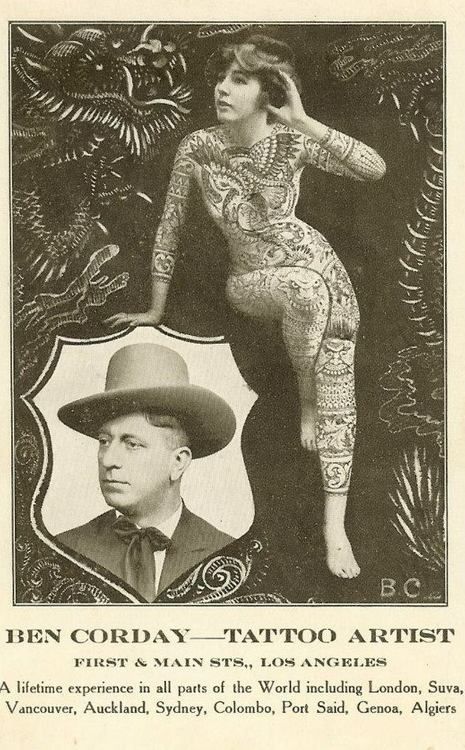
- Charlie Wagner (1875-1953) Nicknamed “Michelangelo of Tattooing”, one of the great legends of the American tattoo, he developed his career in New York City. Working on the Bowery in lower Manhattan, Wagner took over the store space at number 11 Chatham Square that Samuel O ‘Reilly, his teacher had occupied. In fact, Charlie Wagner really continued O’Reilly’s work in more ways than one; If Samuel O’Reilly patented the first tattoo machine in 1891, Wagner improved that design and received his own patent in 1904. In fact, most machines built today are based on that Wagner design.
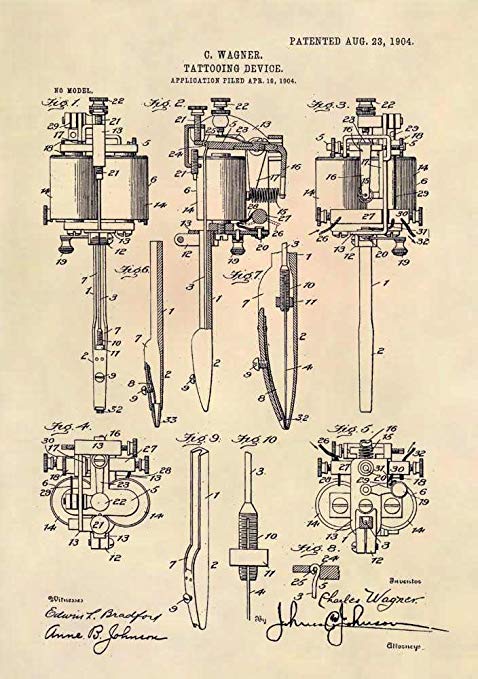
- Gus Wagner (1872-1941) “The tattooed globertrotter”, although they shared a surname there is no kinship between Gus and Charlie (to be known). At that time there were already the first tattoo machines, but Gus Wagner was one of the few tattooists who continued with the classic style “hand-poked”. They achieved very detailed designs performed manually with a stick or needle that was dipped in ink. In addition to leaving an incredible collection of flashes, Gus instructed and taught the “stick and poke” technique to his wife Maude Wagner, with whom he also exchanged tattoos. The daughter of both, Lovetta Wagner in addition to acting in circuses, would follow the profession of their parents.

- Maude Wagner (1877-1961) Maud learned from her husband, Gus Wagner, the traditional tattoo technique and adopted that art form, and together with her husband, spread it all over the country. She finished with the body covered in tattoos made by her husband; he drew mythical and wild animals, exotic plants, indigenous women and even her name. In a time when tattoos were not well seen because they were considered wild art or typical of lower classes, Maud broke the prejudices of a male-dominated field and became a talented artist and the first professional tattooed woman known.

- Bert Grimm (1899-1985): he hovered around tattoo shops at 10 years old, pointing to a child prodigy. An authentic figure in the traditional tattoo world. He learned the trade of Sailor George Fosdick and Sailor Gus in Portland, to open, then, his first studio in Chicago in 1916. After a tour of a few years by Hawaii and Asia, he returned to the USA to settle in his legendary studio in Long Beach California Nu Pike, where he worked with some of the greats in the business, including Domingo Gulang, Charlie Barr, Thomas Tatts, Red Gibbons, Walter Torun, Bob Shaw and Todd Col, among others.
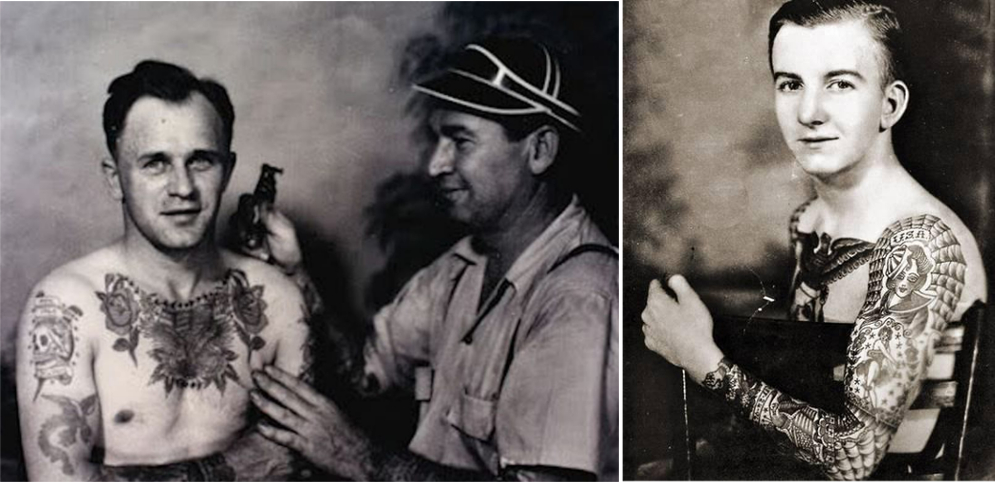
- Percy Waters (1888-1952): linked from childhood to fairs and shows, began tattooing as a hobby alternating with his work in a foundry, which later would help him build a good name, not just as one of the tattooists Laureates, also as owner of one of the most successful tattoo equipment business of the moment. In 1929 he patented the electric tattoo machine and ended his days at the head of his company in Alabama.
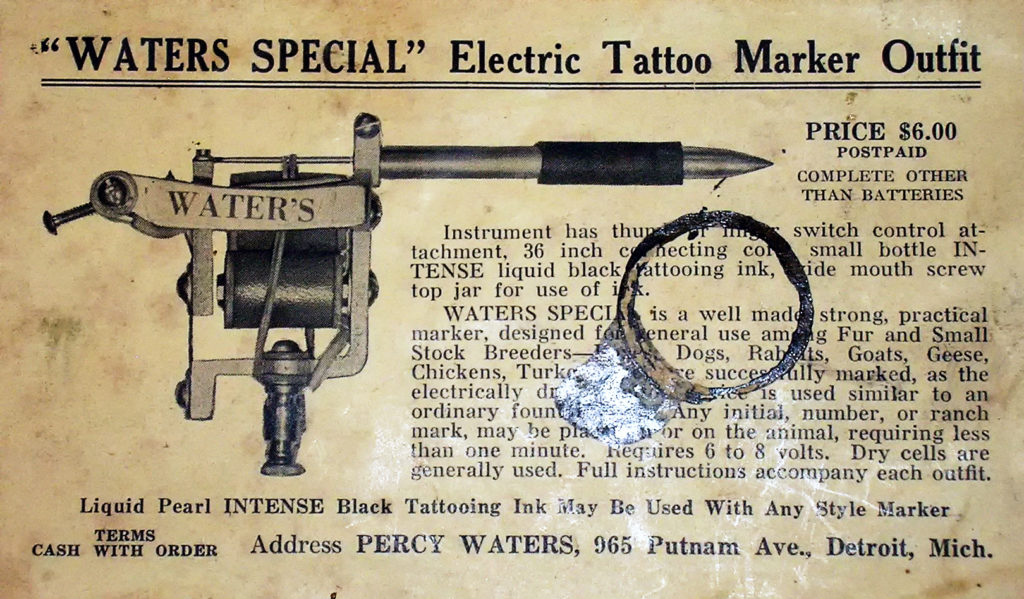
- August “Cap” Coleman (1884-1973): he was a teacher of tattoo artists such as Leonard L. “Stoney” Clair. He managed his own studio until the 1950s in Norfolk, Virginia, and leaves behind an endless series of classics that many artists continue to use today. Many of Coleman’s tattoos, which included the big eagle, the bunker of the flag, the boat in the stomach, the sun designs on the kneecaps, could be seen in the small statue that was shown in the window of his shop in Norfolk. This statue is now part of the collection of the Mariner’s Museum in Newport News, Virginia.

- Albert Kurzman “Lew the Jew” (1880-1954): tattoo artist of Jewish origin, he studied drawing and metallurgy in high school. It is said that Albert was a wallpaper designer rather than a tattoo artist. He worked for several years with Charlie Wagner in Chatham Square. He was the first to redesign and put flashes on sale in New York City. Flashes that you can find in a compilation book that bears the name “Lew the Jew Alberts: Early 20th Century Tattoo Drawings“.
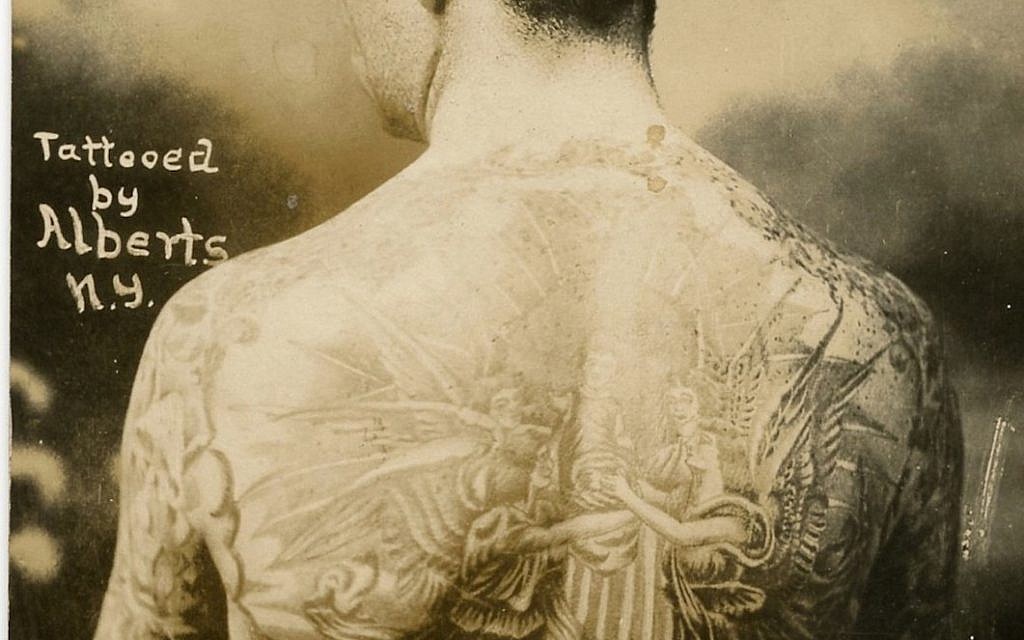
- Owen Jensen (1891-1976): pioneer in Detroit, he left incredible classics, as well as a great legacy in the construction of machines. After fighting in World War I, Owen, he began to work in several cities and different shows, later with a crowd of artists of the time, Charlie Barr, Coleman, Sturtz or Lee Roy, among others and in different studios and tattoo parlors. Linked to the circus world, as was usual in the tattoo scene, he married Dainty Dolly, a famous circus fat woman, who would end up covering tattoos, according to the story.
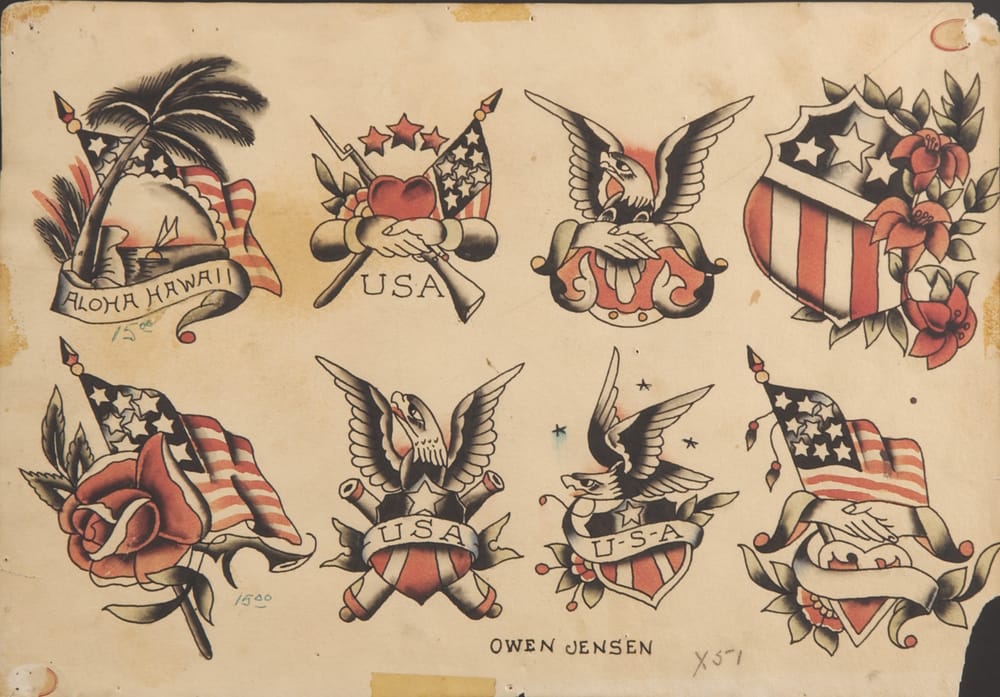
- Norman Collins aka Sailor Jerry (1911-1973): military by profession, considered one of the most influential people of the Traditional American Tattoo. After training in Chicago, he was instructed by Tatts Thomas, he ended up setting up his own tattoo studio in Honolulu, Hawaii. Very much influenced by Asian culture, Jerry deeply admired the work of Japanese tattoo masters and was the first foreign to enter regular correspondence with them. However, he was also determined to beat them at his own game. He picked up the “Japanese” style and fused it with the Traditional American, leaving behind countless super solid and clean tattoos. Swallows, daggers, ships, dragons, and many other designs that we have seen hundreds of times, are classics of the mythical Saylor Jerry. Ed Hardy and Mike Malone, would follow his way very influenced by him. Norman´s parlour, Sailor Jerry’s Hotel Street, was the place where the new sailors and soldiers arrived to be tattooed for the first time. The Hawaiian Islands served as the main outlet to Asia and that allowed Sailor Jerry to study the craft and Irezumi style, the traditional Japanese tattoo art. Throughout her career, Sailor Jerry devoted herself to exploring the elements belonging to the different styles of Japanese tattoo, and mixed them with her own elements. His legacy can be seen in Sailor Jerry’s own flash tattoos, and in the influence that his work has had within the American tattoo style.

Classic tattoo, World War II and evolution
In addition to the contribution of these and many other artists, the II World War marked an important turning point in the consolidation and evolution of the traditional style. Young Americans were sent to a war from which many did not return.
In this context, the soldiers and sailors, increasingly tattooed, did not lose a second to think about what they would say, so in their few leisure times they took advantage of to get a tattoo. Love, nostalgia, vice, patriotism or struggle were some of the most recurrent themes. Honolulu, and Pearl Harbor in particular, was a destination of solera for which many soldiers passed, leaving with a piece for their collection was almost mandatory.
In the 50s and 60s the traditional tattoo remained linked to people who did not want to go through the hoop of society. He also became increasingly associated with convicts; that’s why tattooing was not very well seen. Also, he was very close to the bikers who considered the tattoo as a distinctive engraved on fire, something for life.
The truth is that from the 60s the tattoo progressed thanks to artists like Cliff Raven or Jamie Summer, among many others. The repertoire of designs grows hand in hand with increasingly younger artists. So that later, in the 70s and 80s, when the punk movement was a trend, under his cut cowboy jackets began to see classic pieces that served to reinforce his image.
Technical Aspects of the American Traditional Tattoo
The traditional tattoo is characterized by some basic details: thick lines, firm and without modulation. With solid primary colors, reds, yellows, greens, blues and a lot of black. Simple designs or great abstraction that within them have an absolute complexity, the composition is balanced and detailed but not excessive, there are no realistic details as it always responds to the basic rules of light and shadow.
Many masters of the American tattoo emerged, as we already spoke some lines above. But it is indisputable that Norman Collins (Sailor Jerry), was a pioneer in the tattoo culture in the West. As tattoos became more popular among Allied military servicemen during World War II, Sailor Jerry found himself opening a tattoo shop in Honolulu (Hawaii), a prominent stage in the history of tattooing.
Tattoo old school today
At present, the “American-tattoo”, also known as Old-School, remains intact with its solidity, cleanliness and all its essence. The biggest change is the brutal technological advance. The “tattoo suppliers” improve their performance: better inks, lighting, furniture and infinity of resources. Even from Leaf Pro, doing the same, trying to contribute a bit to the current tattoo scene.
The interaction and the imitation, sometimes excessive, between artists continues to exist but the great advance that social networks have involved in the promotion of artists and the acceptance of the tattoo in society play a key role in this growth.
As time has passed, different tattoo styles have developed in the West, and many of them have evolved. Nowadays, almost anywhere in the world you can find a tattoo studio, and with high probability with a good tattoo artist that fattens your collection. What used to be a culture represented mainly by tattoos of pin-up girls, anchors and knives, has expanded, giving way to the added value of elegance and the pieces worked. Some artists prefer the style where line and drawing are highlighted, others give value to geometric patterns, others, however, cover large areas of skin with solid black. What is certain is that today a new counterculture has been created, which becomes more popular every day, where tattooing has become not just a preponderant accessory, it is a way of life.


Flow Art
Hermoso todo esto!!!!
Kevin Martínez
Información de mucho valor
Eduh
Muy interesante,obtuve lo que quería saber, muchas gracias